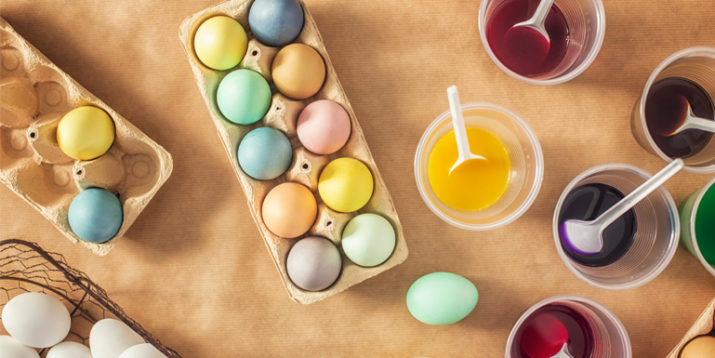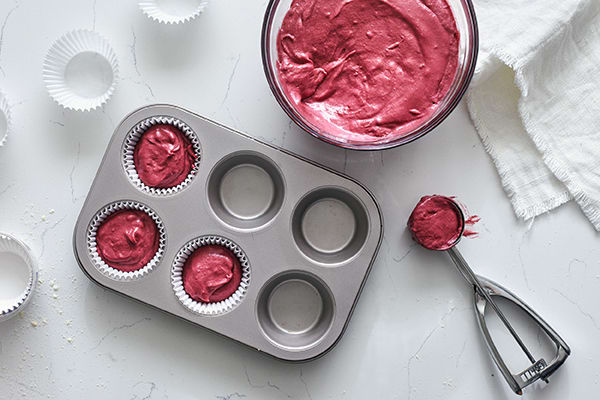How to Make Homemade Easter Egg Dye

Deep down, you know that you don’t actually need your food to come in bright colors.
Still, there’s no denying that rainbow bagels or neon cupcakes are just way more fun.
The problem is, artificial dyes don’t exactly have a great track record health-wise, say experts at the Center for the Science in the Public Interest.
So why risk cooking or baking with them, especially when it’s so simple to make natural food coloring at home?
There’s a way to create any colored dye sans weird chemicals by using fruits, vegetables, and spices that get their pigment from Mother Nature.
And don’t worry — since you only need a few concentrated drops of your homemade food coloring, it won’t have an impact on the flavor or texture of the food you add it to.
Here’s exactly what you need to make natural food coloring and create your favorite hue.
Red and Pink: Beets
It’s no surprise that beets make the best red food coloring since they stain practically everything they touch.
To harness their hue, cut uncooked, peeled beets into chunks and place them in a small pan with enough water to cover them. Bring the beets to a boil, then simmer them until they’re easily pierced with a knife.
Once the beets are cooked, strain the liquid. To get a more concentrated color, simmer the liquid even longer until it reaches the consistency of syrup.
Now, you’re ready to use it just like store-bought red food coloring: Add one or two drops for pink, or add a few more for a deeper red.
And save those beets! They’re tasty in salads or blended into hummus or smoothies.

Yellow: Turmeric
This superfood spice drenches everything it touches in a sunny, golden yellow. And using it couldn’t be easier: Stir a teaspoon or so of ground turmeric powder into your recipe, and that’s it.
If you need to adjust the consistency for the recipe or the tone down the vibrancy of the yellow, you can mix a few teaspoons with water before you add it to the food.
Orange: Carrots
Making orange dye with carrots is just like making red dye with beets: Just simmer the carrots until their color infuses the water, and add a few orange drops into whatever food you’re looking to brighten up.
If the carrots aren’t giving you the shade of orange you’re looking for, try mixing a few drops of red with a few drops of yellow.
Green: Spinach or Matcha Powder
Making green food coloring is similar to making red or orange food coloring (are you seeing a pattern yet?).
Simmer a few handfuls of spinach in water for about 15 minutes, until the water turns a bright green color. Then, dump the spinach and the water in the blender, and blend until completely smooth.
You can run the mixture through a strainer for extra insurance, then use it however you please.
Another option? Just use matcha, the green tea powder. Like turmeric, swirling a spoonful into your recipe is enough to yield a vivid color that will make anyone green with envy.

Blue: Red cabbage and Baking Soda
Fun fact: When you combine red cabbage with a little bit of something alkaline, like baking soda, the cabbage turns blue.
To make blue dye, boil a head of shredded red cabbage in enough water to cover it, until the cabbage is completely limp.
Strain the liquid, add half a teaspoon of baking soda, and watch as your liquid changes from purple to blue. But be sure you only add half a teaspoon – using too much can create a soapy flavor.
Purple: Purple Grape Juice
To get the most royal purple possible, bring grape juice to a boil and then simmer until the mixture is thick and syrupy.
Use it just like you would other homemade liquid food dyes. A few drops should add plenty of color without infusing the grape flavor.
What About Other Colors?
Once you have the basic primary and secondary colors, you can mix them to make all kinds of other hues.
It might take a little bit of experimenting to get exactly what you want — but that’s part of the fun, right?
Here are a few basic combos to get you started:
- Magenta: Red + purple
- Teal: Blue + green
- Salmon: Red + orange
- Indigo: Blue + purple
- Olive: Green + yellow

